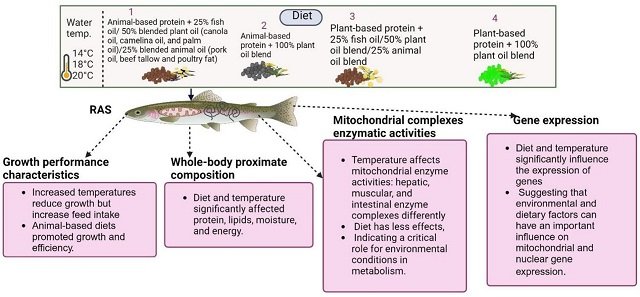
In the face of climate change, sustainable aquaculture has become an urgent concern. A major challenge lies in developing alternative feed sources for carnivorous fish, such as rainbow trout, that can reduce reliance on marine ingredients.
To mitigate the environmental impact of this dependency, researchers from West Virginia State University (USA), Abernathy Fish Technology Center Longview (USA), USDA ARS Bozeman Fish Technology Center, and Cornell University investigated the effects of plant-based alternative diets and variable water temperatures on the growth, physiology, and gene expression of rainbow trout (Oncorhynchus mykiss). A central aspect of the research, published in the journal Aquaculture, is the role of mitochondria—the powerhouses of cells—in influencing growth, nutrient utilization, and overall fish health.
Mitochondrial Function and Aquaculture Sustainability
Mitochondria are essential for energy production through oxidative phosphorylation (OXPHOS). Their activity is influenced by various factors, including nutritional composition and environmental conditions. Dietary ingredients, particularly protein and lipid sources, can significantly affect mitochondrial gene expression and enzyme activity. Studies have shown that plant-based alternatives to fishmeal and fish oil can be incorporated into rainbow trout diets without compromising growth performance.
Water temperature also plays a crucial role in mitochondrial function. Rainbow trout is a cold-water species, and elevated temperatures can negatively affect their metabolic processes, growth, and stress tolerance. Understanding how dietary factors and water temperature interact to influence mitochondrial function is vital for optimizing aquaculture practices.
The Experiment: A Multifaceted Approach
Researchers conducted a comprehensive experiment with 432 rainbow trout. The fish were divided into groups and fed four different diets, each varying in protein source (animal-based or plant-based) and oil composition. Water temperatures were also manipulated to simulate different environmental conditions.
- Key Findings: Temperature and Diet Matter
- Temperature matters: Warmer water temperatures (18°C and 20°C) negatively affected growth performance, feed efficiency, and feed intake compared to cooler conditions (14°C).
- Dietary impact: Fish fed diets containing animal-based proteins and fish oil generally exhibited superior growth and feed efficiency compared to those fed plant-based alternatives. However, the specific composition of plant-based diets also influenced outcomes.
- Temperature-diet interactions: The combined effects of temperature and diet were significant for certain physiological parameters, such as body composition and mitochondrial function.
Beyond Growth: Health and Metabolism
The study also explored the effects on fish proximate composition (protein, moisture, and lipid content) and mitochondrial function. While temperature primarily influenced overall composition, the interaction between temperature and diet played a crucial role in affecting specific levels of proteins, lipids, and energy.
Mitochondrial enzyme activities, essential for energy production, were also affected by temperature and dietary factors. The liver, muscle, and intestine showed distinct responses to these variables, highlighting the complex interplay between environmental conditions and nutritional needs.
Gene Expression: A Molecular Perspective
To better understand the underlying mechanisms, researchers examined gene expression patterns in different tissues. Genes involved in mitochondrial function and energy metabolism were significantly influenced by both temperature and diet composition.
Stay Always Informed
Join our communities to instantly receive the most important news, reports, and analysis from the aquaculture industry.
Implications for Trout Farming
The findings of this study provide valuable insights for developing sustainable aquaculture practices. By carefully considering both water temperature and diet composition, it is possible to optimize rainbow trout growth and productivity while minimizing environmental impacts.
Conclusion
This study offers valuable information on the complex relationship between diet and temperature in rainbow trout aquaculture. By understanding these interactions, we can develop more sustainable and resilient production systems that can meet the growing demand for high-quality protein while minimizing environmental impacts.
Further research is needed to explore the long-term effects of these factors on fish health, reproductive performance, and overall sustainability. Additionally, investigating other potential alternative feed ingredients and their interactions with environmental conditions will be crucial for advancing sustainable aquaculture practices.
The study was funded by the National Institute of Food and Agriculture (NIFA)/ United States Department of Agriculture (USDA).
Reference
Idenyi, J. N., Abdallah, H., Adeyemi, A. D., Huber, D. H., Gannam, A., Sealey, W., Igwe, D. O., & Eya, J. C. (2024). Optimizing growth and mitochondrial function in rainbow trout, Oncorhynchus mykiss through eco-friendly dietary and changes in water temperature regimen strategies. Aquaculture, 741591. https://doi.org/10.1016/j.aquaculture.2024.741591
Editor at the digital magazine AquaHoy. He holds a degree in Aquaculture Biology from the National University of Santa (UNS) and a Master’s degree in Science and Innovation Management from the Polytechnic University of Valencia, with postgraduate diplomas in Business Innovation and Innovation Management. He possesses extensive experience in the aquaculture and fisheries sector, having led the Fisheries Innovation Unit of the National Program for Innovation in Fisheries and Aquaculture (PNIPA). He has served as a senior consultant in technology watch, an innovation project formulator and advisor, and a lecturer at UNS. He is a member of the Peruvian College of Biologists and was recognized by the World Aquaculture Society (WAS) in 2016 for his contribution to aquaculture.




